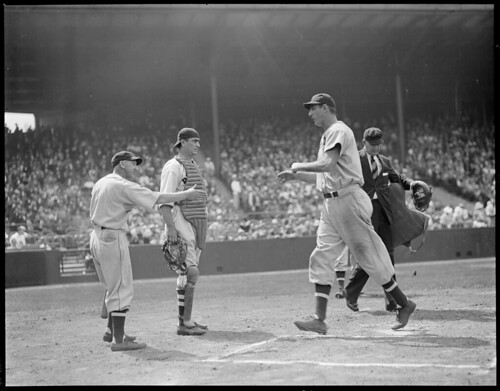Hammerin' Hank Greenberg:At over 6 feet tall, Hank Greenberg was a powerful hitter and a first baseman with a long reach. Signing with the Detroit Tigers in 1930, Greenberg rose to fame during the Great Depression and during a time when many ethnic groups faced discrimination and prejudice - on the ball field and off. As Sommer writes, "Hank Greenberg was not the first Jewish man to play in Major League Baseball, but he quickly became the most widely known" (p. 43). In 1938, Greenberg came within 4 home runs of breaking Babe Ruth's home run record. Sommer quotes a Detroit fan from the 1930s:
Baseball Pioneer
by Shelley SommerPA: Calkins Creek, 2011ages 10 - 142012 Sydney Taylor Honor Book
"'I don't think anybody can imagine the terrific importance of Hank Greenberg to the Jewish community, said one Detroit fan. "He was a God, a true folk hero.' Some Jewish publications began referring to Greenberg as the 'Jewish Babe Ruth'" (p. 44-45).Throughout this story of Greenberg's career, Sommer interweaves a backdrop of American history in the Great Depression and World War II. This is particularly effective for tweens who may have some understanding of American history, but who may not understand how it affected sports players. I was interested in the parallels Sommer drew between boxer Joe Louis's role in boxing, being a champion for African Americans, and Greenberg's role as a hero for American Jews.
 |
| Hank Greenberg, crossing home plate, is greeted by Detroit catcher Moe Berg, 1937 |
"Baseball is a game that affords any youngster an opportunity to progress. Ability is the sole determining factor in advancement, and not religion, the way your hair parts or your parental lineage." In a handwritten postscript, he added: "If prejudice does exist and I refuse to recognize that it does does, then let it spur you on to greater achievement rather than accept it and be licked by it" (pp. 104-105).For me, this sums up Greenberg's positive attitude, determination and dignity. He withstood jeers from opposing players, and kept playing his very best through hard times and good.
The backmatter provides interesting insights into Greenberg's life and Sommer's sources. Baseball fans I shared this with were particularly interested in the all-star baseball team that Greenberg named, and wanted to know more about the other players he included. Sommer includes a list of further resources for readers to learn more about Hank Greenberg and the history of the times when he played baseball. She also includes a full bibliography and source notes. The one item I would have found useful is a timeline to visually integrate the different events described, both in Greenberg's life and American history.
I am looking forward to interviewing Sommer this weekend as part of the Sydney Taylor Blog Tour. For more details see the Association of Jewish Libraries for their full announcement.
Other reviews you might be interested in:
- The Nonfiction Detectives: "The many-layered book is more of an overview of Greenberg’s career. The author also highlights what it was like to be Jewish at a time when Anti-Semitism was escalating because of the growing turbulence in Germany that would become World War 2."
- ProseandKahn: "This is a comprehensive birth to death biography that is totally accessible to the middle school reader."
The review copy came from our local public library. If you make a purchase using the Amazon links on this site, a small portion goes to Great Kid Books (at no cost to you!). Thank you for your support.
Review ©2012 Mary Ann Scheuer, Great Kid Books

No comments:
Post a Comment